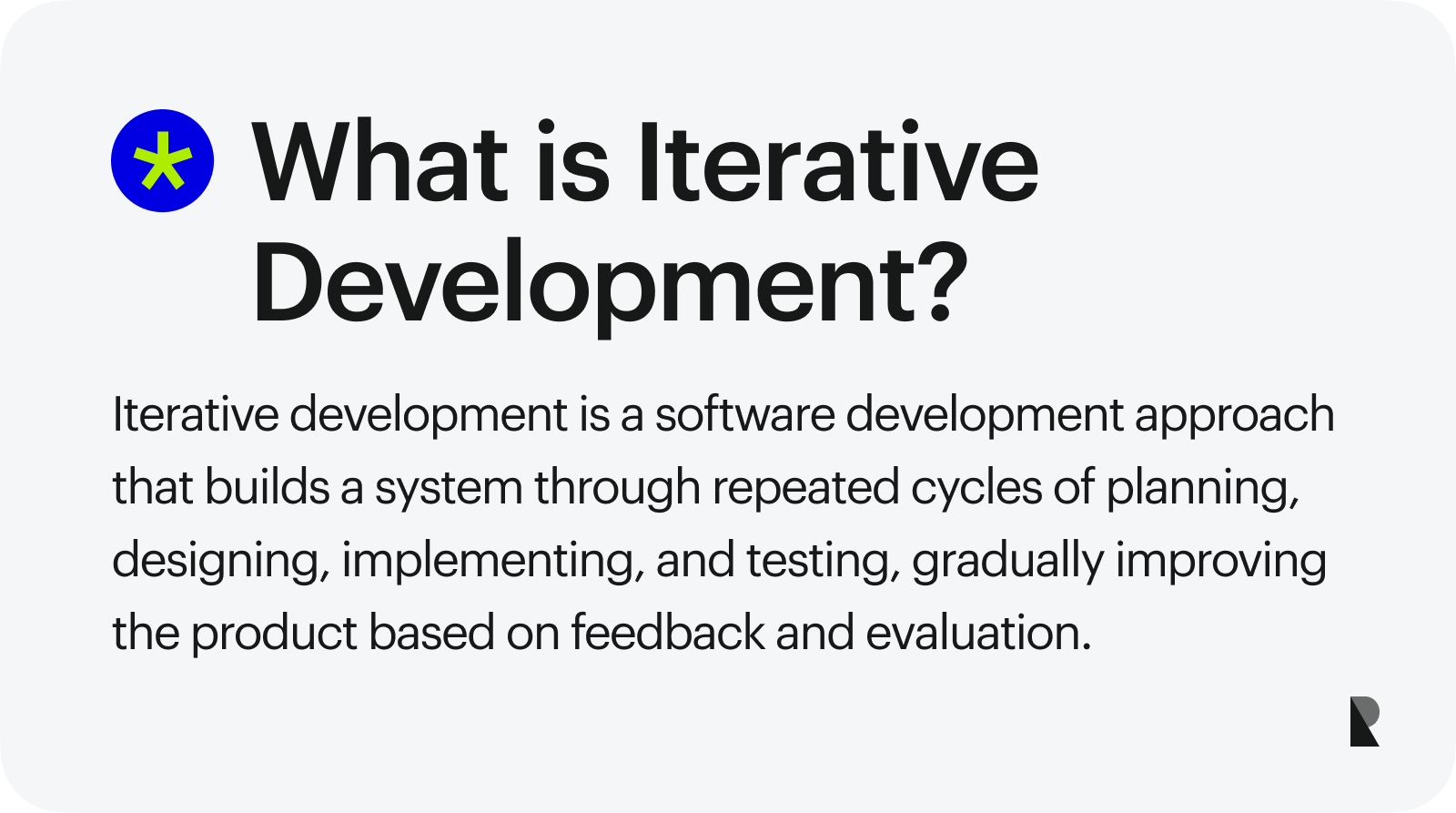
The world of software development is constantly evolving. New technologies emerge, user expectations grow, and businesses face pressure to deliver faster than ever.
In such an environment, relying on outdated methods can slow progress and create products that no longer meet real needs. To keep up, teams need approaches that support adaptability and ongoing improvement.
That is where iterative processes come in. By focusing on steady progress and continuous refinement, they help teams handle change with confidence. An Iterative process makes it possible to improve software step by step, keeping projects relevant and aligned with shifting goals.
This article breaks down iterative processes and shows how they make software development more flexible and user-focused.
Read along to learn how iterative processes work, why they matter, and how they shape the future of modern software development.
Introduction
Iterative development is the incremental development of software. This means the development team works in small cycles rather than trying to deliver everything simultaneously. Each cycle produces a usable part of the product that can be tested, reviewed, and improved.
This approach is vital in modern software development because it supports continuous improvement. The team can spot issues early, adjust plans, and refine the product as they go. Unlike traditional models such as the Waterfall method, which follow rigid and linear steps, iterative development stays flexible.
Today’s markets are fast-paced and feedback-driven. Users expect quick updates and features that match their needs. Using the iterative approach, you deliver value faster and stay aligned with real user demands.
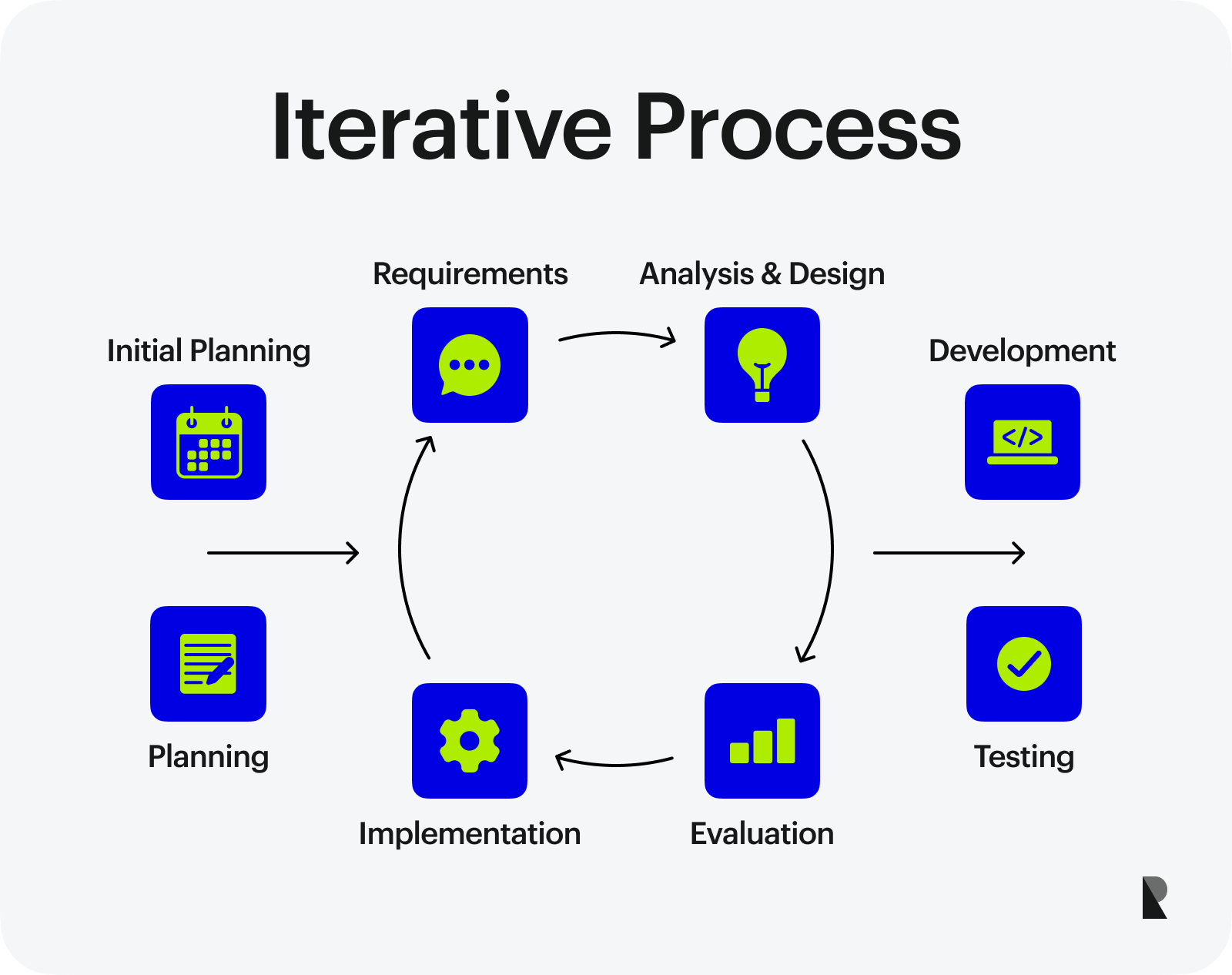
Defining Iterative Development
Iterative development is more than just a method. It is a mindset that helps teams build software step by step and refine it through feedback and improvement. By working iteratively, a development team reduces risks, adapts quickly, and delivers value faster.
What is iterative development?
Iterative development is an incremental model that delivers software in cycles, using feedback and testing in every step for continuous improvement.
Definition & principles
Iterative development is an incremental approach to software development in which projects are divided into smaller cycles, often called iterations. Instead of trying to deliver the entire product at once, the project team develops, tests, and refines parts of the software in repeated stages.
Each cycle builds upon the previous one, creating opportunities for learning, improvement, and faster value delivery. The iterative development is guided by a few key principles that shape the entire process:
Cycles
Work is broken down into smaller, manageable stages. Each cycle focuses on a limited set of features or requirements, making it easier for the project team to stay focused and organized. This also reduces complexity and ensures steady rather than overwhelming progress.
Repetition
Revisiting and refining software improves it in every cycle. By repeating the process, teams can resolve issues, enhance features, and strengthen the product incrementally. This repetition means the product continuously evolves instead of staying static until the final stage.
Team effort
Collaboration drives every stage of iterative processes. Developers, testers, designers, and stakeholders all play a role in shaping each iteration. This shared effort fosters clear communication, accountability, and creativity, leading to better decision-making and stronger outcomes.
Measurable results
Every iteration delivers a working version of the software. Even if it is a small part, it provides tangible results that can be tested and reviewed. These measurable outcomes ensure that progress is visible, risks are reduced, and stakeholders stay engaged throughout the project.
These principles make iterative processes effective and practical in today’s fast-moving software environment.
Iteration in agile teams
Agile methods like Scrum and Kanban use iterative development as their foundation. Teams plan short sprints, deliver small increments, and improve continuously. This allows them to adapt to customer feedback quickly and adjust priorities as needed.
For example, when a business hires an app development company working iteratively, the team can release a basic version of an app, gather feedback, and refine features in the next cycle.
Partnering with a custom web application development firm that applies these principles can further enhance collaboration efficiency and product adaptability, ensuring each iteration reflects real user needs. This approach ensures the product stays relevant and delivers real user value. Focusing on continuous improvement helps avoid wasted effort and keeps projects aligned with business goals. Thus, the final iteration results in a product aligned with user demands.
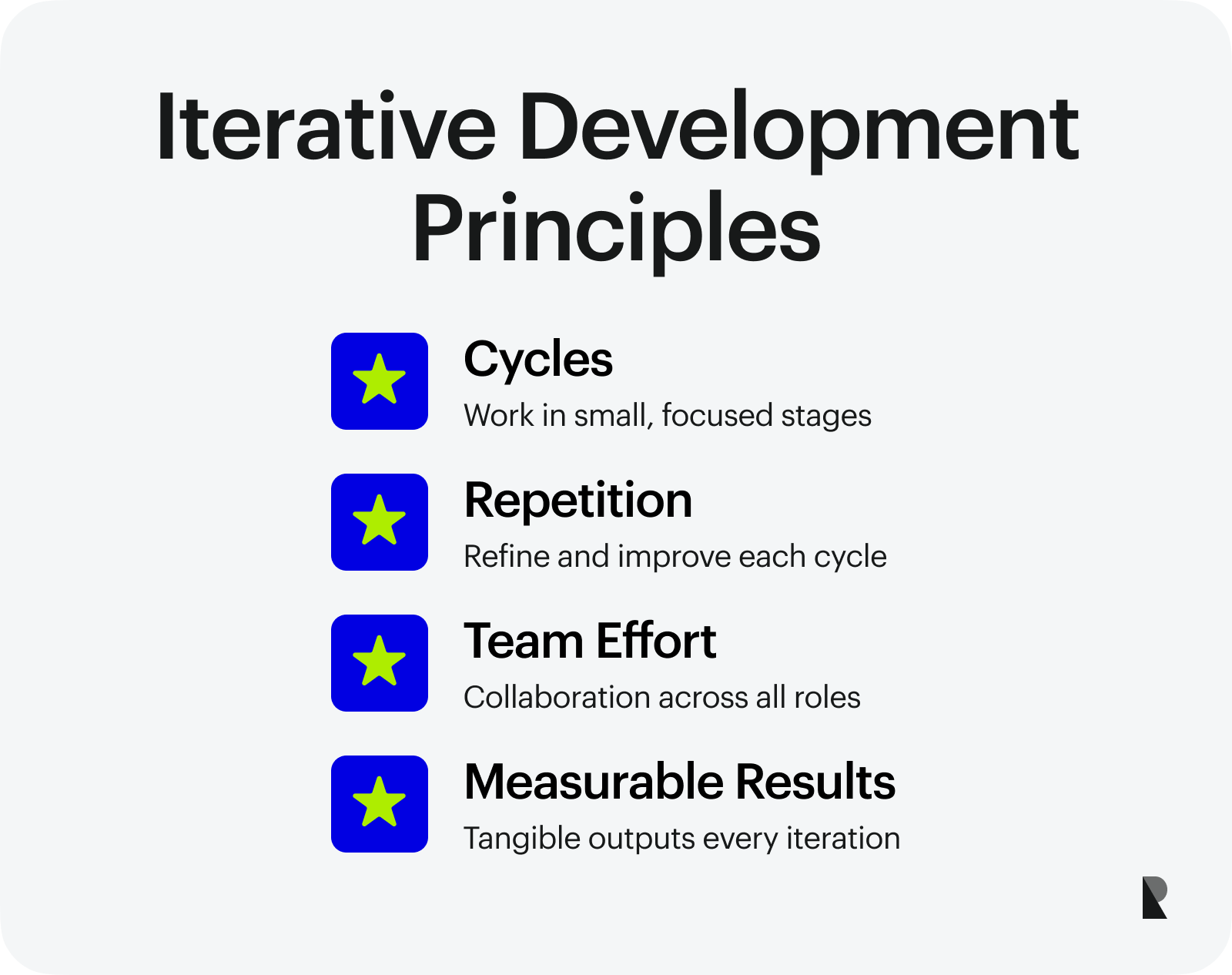
Hence, iterative processes combine incremental progress with customer feedback to deliver better results. When teams use iterative approaches, they create flexible, adaptive software that meets real needs.
Iterative vs. Traditional Models
Regarding project development, teams often compare the iterative model with the traditional Waterfall approach. Both aim to deliver software, but they follow very different paths.
The iterative process focuses on flexibility and feedback, while the non-iterative process relies on strict planning and fixed steps. Let’s dissect how these two approaches compare.
Flexibility vs. Rigid planning
In the iterative model, teams work in cycles and adapt. They can add new features, adjust technical requirements, and refine design based on feedback from end users. The Waterfall model follows a noniterative process. It moves step by step, with little room for changes once the plan is set. This makes it harder to adapt when the project needs to shift.
Risk reduction with feedback loops
The iterative process allows issues to surface early. Teams test and review in previous iterations, so problems are spotted before they grow bigger, reducing risk throughout project development.
In a traditional model, risks often go unnoticed until late in the project. If critical issues surface, fixing them may require major redesigns or starting over. This reactive approach increases costs, wastes effort, and delays delivery.
Faster delivery & time-to-market
Working iteratively speeds up delivery. Each cycle produces usable software, so end users can use core features early and see improvements with each release. This shorter time-to-market gives businesses an edge, especially in competitive industries.
With a traditional process like Waterfall, the product is delivered only after all stages are complete. This slows down time to market and delays feedback from real users. By then, user needs may have shifted, making the product outdated before it even launches.
| Aspect | Iterative model | Traditional (waterfall) model |
|---|---|---|
| Approach | Works in cycles with continuous refinement | Follows a linear, step-by-step sequence |
| Flexibility | Highly flexible; adapts to feedback and change | Rigid; limited scope for changes once planned |
| User involvement | End users provide feedback in every iteration | End users see the product only after completion |
| Risk management | Issues surface early through feedback loops | Risks often appear late, making fixes costly |
| Delivery | Produces usable software in each cycle | Delivers the product only after all stages |
| Time-to-market | Faster; updates and new features roll out quickly | Slower; long delays before release |
| Focus | User-centered, value-driven improvements | Documentation-heavy, process-centered |
| Project requirements | Can evolve with changing needs | Must be fixed at the start of the project |
Thus, an iterative model is adaptable, ensuring improvements in every cycle. Unlike the traditional approach, it puts users at the center of project development, making it a stronger choice for projects in today’s fast-moving, user-driven market.
Benefits of Iterative Development
The iterative development process focuses on progress through small, repeatable steps. Each cycle builds on the last, adding value and refining the outcome. This approach allows for feedback, problem-solving, and adjustments along the way.
Below are some key benefits of using iterative processes over the traditional non-iterative ones.
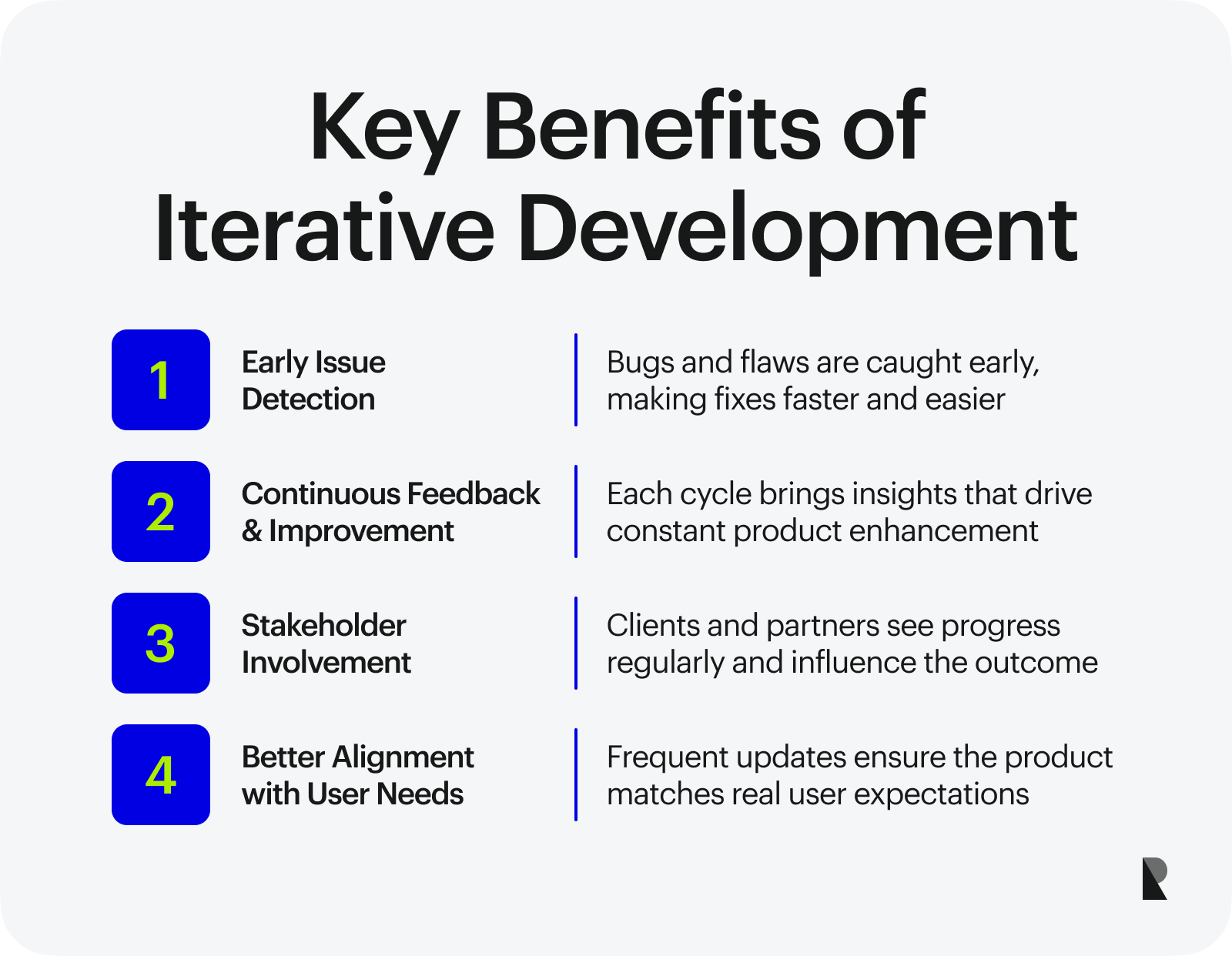
Key benefits of iterative development (Collidu)
Early issue detection
One of the most significant advantages of iterative processes is early issue detection. Bugs and design flaws appear in the first cycles, not at the end. Team members can fix problems quickly before they grow into bigger challenges. This makes project management smoother and keeps the software application more reliable.
Continuous feedback & improvement
The iterative process thrives on feedback loops. Every iteration allows the team to review, learn, and improve. Continuous feedback drives continuous improvement, making the software better with each cycle. This means the final product is refined and ready to meet real-world demands.
Stakeholder involvement
Iterative development keeps stakeholders close to the process. Instead of waiting until the end, clients and partners see progress at every stage. This builds trust and helps align expectations. It also ensures that project development moves in the right direction with clear input from all sides.
Better alignment with user needs
Frequent updates in the iterative model help align the software application with actual user needs. End users can test features, share opinions, and guide changes.
For businesses choosing to hire web app development agencies, working with a team that follows an iterative process means faster adaptation and a better-fitting product for users. This keeps the software relevant and competitive.
Thus, iterative development benefits project management, team members, and end users. By working through every iteration, the project stays on track, adapts to change, and delivers better results than a non-iterative model ever could.
Iterative Development Cycle Steps
The iterative development process follows a clear path. Each step builds on the previous one, making progress steady and measurable. Unlike a non-iterative approach, this cyclical approach allows the project team to adapt and improve.
Through incremental development, a project is developed and tested many times before reaching the final product. The following are the key steps included in an iterative development cycle.
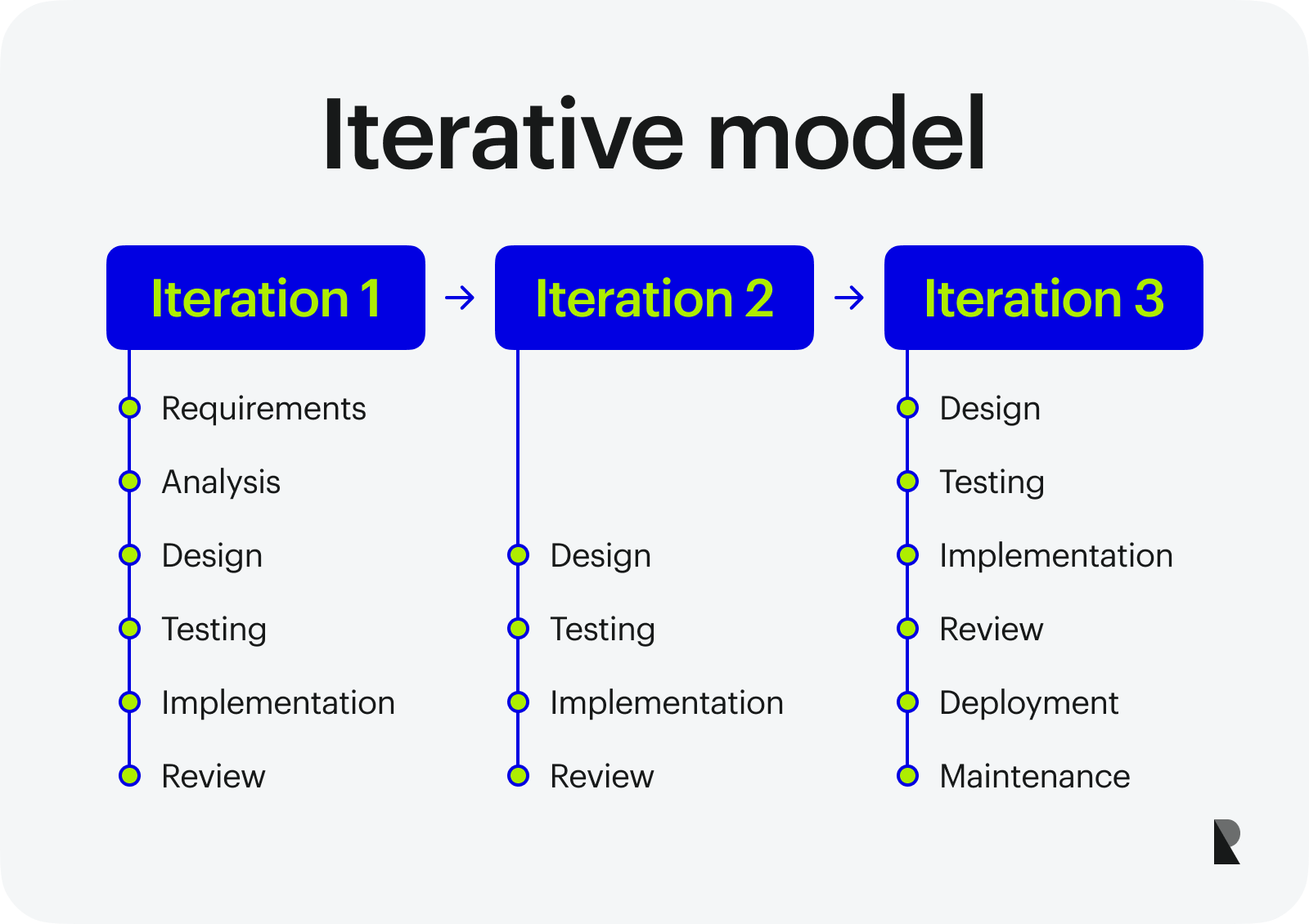
Plan the iteration
Every cycle of an iterative process begins with planning. The project team sets clear goals for what they want to achieve during the iteration. These goals are based on:
- Project requirements: these are details of what needs to be delivered to the end user
- Business priorities: this highlights which features add the most value to the product
- User expectations: these refer to what end users want and need
The planning stage also includes estimating time, resources, and skills needed. This step ensures everyone is aligned before the development process begins.
Analyze requirements
Requirements are rarely static. User feedback, market shifts, or technical challenges can lead to changes as the project moves forward. In this step, the team reviews and updates requirements to reflect evolving needs.
By adapting requirements early, the development process avoids building features that no longer serve the project’s goals, ensuring the product remains relevant to the changing needs of the market and the end user.
Design the increment
Planning and analysis ultimately lead to designing the incremental development of the project. It sets the foundation for what will be built in this iteration. The project team works on different levels of design. Some key levels include:
- User interface (UI): This refers to the look, feel, and usability of the software
- System architecture: It determines how different components of the project interact
- Logic and functionality: These are the rules and operations behind the features
A well-thought-out design ensures the increment is functional and fits the overall product cohesively.
Implement features
Once the design is finalized, it leads to the hands-on building stage. During this cycle phase, developers write code, integrate modules, and build the planned features. The iterative processes allow developers to:
- Focus on smaller, manageable portions of the product
- Reduce complexity by working step by step
- See quick results that motivate progress
Test & validate
Like every other project that businesses work on, the iterative process is incomplete without testing and validation. This stage of the cycle ensures that the incremental development works as expected.
This step depends on the following two methods:
- Manual testing - it is used to check usability and spot design flaws
- Automated testing - this confirms performance, functionality, and code quality
Validation confirms the increment meets project requirements and functions well within the larger product. Early testing helps identify bugs before they become serious problems later in the development cycle.
Collect feedback
Once the increment is ready, it is shared with stakeholders or end users. Feedback is collected through demos, surveys, or real usage data. This input is critical for improving the product in future cycles. By listening to user feedback at every iteration, the project team ensures the software application stays aligned with real-world needs and expectations.
Refine & repeat
The key aspect of iterative processes is refining the results after each cycle and repeating the development steps. Hence, the last stage of one complete cycle is to use the lessons of an iteration to refine the product.
Once that is achieved, the goal is to begin the next iteration. It often involves adjustments like fixing bugs, improving design, or adding new features. This step closes the loop and starts the development cycle again, moving the project steadily toward the final product.
Thus, the iterative process makes project development more adaptive, user-focused, and reliable. By breaking work into smaller steps, involving users early, and repeating the cycle, project teams create software applications that evolve naturally and deliver real value.
Conclusion: Iterative Development Trends
Iterative development has changed the way teams build software. Its flexibility allows projects to adapt quickly to new demands. Its speed helps deliver value faster through smaller, usable increments. The iterative process focuses on users, ensuring the products are aligned with their real needs.
These strengths are more important than ever in today's fast-paced software landscape. Markets move quickly, and users expect regular updates and improvements. The iterative processes give project teams the tools to stay competitive, reduce risks, and deliver meaningful results.
Looking ahead, trends like AI-driven automation, DevOps practices, and advanced analytics will make iterative processes even stronger. These technologies will shorten feedback loops, improve testing, and support smarter decisions in every iteration. Thus, iterative processes remain essential in the development landscape. They are not just an iterative process but a proven way to keep your software relevant, reliable, and user-centered in a continuously evolving world.
Sep 11, 2025
